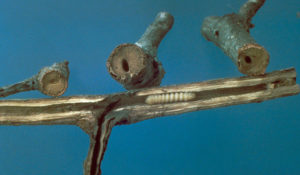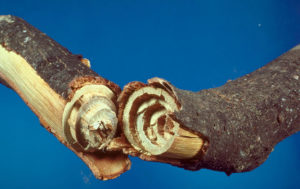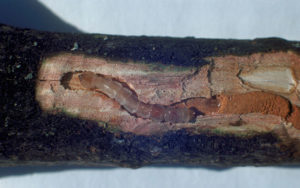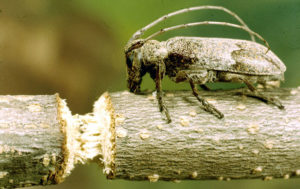Insects that feed on twigs and branches
Scale insects
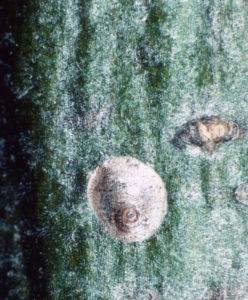
Figure 25. Close up of obscure scales on pecan trunk (Bill Ree, Texas A&M AgriLife Extension Service)
Damage: Scale insects feed by sucking plant sap. Infested branches drop their leaves prematurely, die back, develop rough bark, and may die. Scale-infested trees lack vigor and are more susceptible to borers.
Biology: Scale insects are tiny and live beneath a wax covering, or scale, attached to the bark of a branch or twig. The wax covering of the obscure scale is about 1/8 inch in diameter and dingy gray- brown. It has a dark cap slightly off center (Fig. 25).
As its name implies, this scale is difficult to see on branches and stems because its color blends with the bark. Infestations often go unnoticed.
Large infestations of obscure scale appear as if wood ash were sprinkled along the branch.
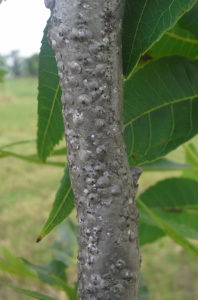
Figure 25. Obscure scales on pecan trunk (J.A. Davidson, Univ. Md, College Pk, Bugwood.org (CC BY-NC 3.0 US))
Immatures that emerge from eggs are called crawlers, the only mobile stage of this insect. Once a crawler has moved and settled in a new location, it begins to feed and excretes the waxy covering. It will never move again.
Females lay eggs beneath the scale cover. There is only one generation per year.
Control: Tree stress can favor scale infestations. Minimize stress by maintaining proper irrigation and fertility for optimum plant health. To reduce spread, prune out branches with large infestations of scale.
Scales are difficult to kill with insecticide sprays because their waxy covering protects them. The crawlers move about on branches for several days before selecting a feeding site and secreting their waxy covering. Although insecticides can be effective if applied when the crawlers are active, this period can last 4 weeks, and later-emerging crawler populations may require repeated
To determine when the crawlers become active, wrap double-sided sticky table around small branches beginning in May. Every few days, use a magnifier to look for crawlers stuck on the tape. Once you see crawlers, apply a contact insecticide to all of the branches
Another control measure is to apply dormant oil in late winter or early spring but before the buds begin to swell. Apply the oil spray thoroughly to penetrate the bark crevices on the trunk and all branches.
Twig pruners, hickory spiral borer, and twig girdler
Damage: Three species of small beetles girdle or bore into pecan twigs and branches, causing the branch or twig to break off and fall from the tree:
- Twig pruners: The larvae cut the branch ends smoothly (Fig. 26).
- Hickory spiral borer: The larvae cut the end of a severed branch in a characteristic spiral pattern (Fig. 27).
- Twig girdlers: The adults, not the larvae, cut twigs (Fig. 28).
Biology: The female beetle deposits its eggs in a twig or branch, and they hatch into larvae that feed in the cut part of the branch or twig. The larvae continue to feed and develop in the branch as it hangs in the tree or after it breaks off during a windstorm.
Control: Reduce infestations of all species by quickly collecting and destroying fallen branches and twigs, which harbor the eggs and larvae.
Red imported fire ant
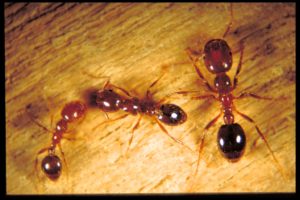
Figure 29. Red imported fire ants. Photo by Bart Drees.
Concerns: Fire ant stings can seriously injure people mowing around trees and harvesting nuts. Red imported fire ants may also damage equipment such as electrical motors and irrigation.
Control: To reduce fire ant numbers, broadcast fire ant bait across the tree area. Fire ants collect the bait particles and carry them back to the colony. Ants eventually feed the insecticide.
to the queens, which become sterile or die. The ant colony dies over a period of weeks or months, depending on the bait product used.
Although many products are available for fire ant control, only some are labeled for use around pecan trees. The label should list pecan or tree nut as a treatment site.
Fire ant baits containing methoprene (Extinguish) can be used in residential areas around flowers, trees, and shrubs and in nut-bearing trees in orchards. Baits containing hydramethylnon (Amdro Pro) and pyriproxyfen (Distance) can also be applied around homes but only to nonbearing pecan trees.
For more information on fire ants, see the Texas A&M Entomology website at https://www.texasinsects.org/.

